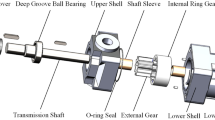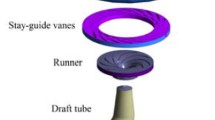Abstract
Steady state flow calculations are executed for turbo-pump inducers of modern design to validate the performance of Tascflow code. Hydrodynamic performance of inducers is evaluated and structure of the passage flow and leading edge recirculation are also investigated. Calculated results show good coincidence with experimental data of static pressure performance and velocity profiles over the leading edge. Upstream recirculation, tip leakage and vortex flow at the blade tip and near leading edge are main sources of pressure loss. Amount of pressure loss from the upstream to the leading edge corresponds to that of whole pressure loss through the blade passage. The viscous loss is considerably large due to the strong secondary flow. There appears more stronger leading edge recirculation for the backswept inducer. and this increases the pressure loss. However, blade loading near the leading edge is considerably reduced and cavitation inception delayed.
Similar content being viewed by others
Abbreviations
- c :
-
Absolute velocity
- p :
-
Static pressure
- p t :
-
Total pressure
- p 0 :
-
Total pressure at inlet
- r :
-
Radius
- r h :
-
Hub radius
- r t :
-
Shroud radius
- R :
-
Spanwise fraction (=r-r h/r t-r h
- ui :
-
Rotational speed of inducer tip
- w :
-
Relative velocity
- β:
-
Blade angle
- p :
-
Density
- w :
-
Angular velocity of inducer
- φ:
-
Flow coefficient (=C ml/u t)
- ψ:
-
Pressure coefficient (=gH/(ρu t 2))
- σ:
-
Cavitation number (= (p l-p v) /0.5ut 2)
- t :
-
Tangential component
- z :
-
Axial component
- m :
-
Meridional component
- 1:
-
Value at inducer inlet
- 2:
-
Value at inducer exit
References
AEA Technology, 1999, CFX-TASCflow user’s documentation, version 2.9.
George Bache, 1994, “Navier-Stokes Computations for The Complex 3D Flow Fields of Inducers and Centrifugal Impellers.” Fifth Int. Symp. on Transport Phenomena and Dynamics in Rotating Machinery, May.
Howard, J. H. G., Tropea, C., Almahroos. H. M. H. and Roeber, T. W., 1987, “LDV Measurements of the Axial Velocity Field Within and Ahead of an Axial Pump Inducer at Off-Design Flow Rate,” Proceedings of the ASME/ JSME Thermal Engineering Conference, Vol. 2, pp. 63–69.
Jackson, E. D. and Cook, R. M., 1983, “Test of SSME Low Pressure Pump in Liquids at Zero Throughflow,” ASME, Performance Characteristics of Hydraulic Turbines and Pumps, pp.179–185.
Moore, J., Doan, Andrew, W. and Moore, Joan G., 1995a, “Performance Evaluation of Rocket Pump Inducers Using a Navier-Stokes Flow Code. Part 1 : 3-D Flow and Inlet Recirculation,” FED-Vol. 227, Numerical Simulations in Turbomachinery.
Moore, J., Doan, Andrew, W. and Moore, Joan G., 1995b, “Performance Evaluation of Rocket Pump Inducers Using a Navier-Stokes Flow Code. Part 2 : Work Contributions and Pump Characteristics,” FED-Vol. 227, Numerical Simulations in Turbomachinery.
Moore, J., Le Fur, T. and Moore, J. G., 1990, “Computational Study of 3-D Turbulent Air Flow in a Helical Rocket Pump Inducer,” AIAA Paper 90–2123.
Tanaka, T., 1980, “An Experimental Study of Backflow Phenomena in a High Specific Speed Propeller Pump,” ASME Paper No, 80-FE-6.
Tsujimoto, Y. and Yoshida, Y., 1998, “Flow Field Measurement at Inlet of 4 Bladed Inducer Using LDV,” Domestic Report of Osaka University.
Tsujimoto, Y., Yoshida, Y., Acosta, A. J., Azuma, S. and Laffite, S., 2001, “Effects of Leading Edge Swept on Unsteady Cavitation in Inducers,” Trans, of JSME, 67(656) B, pp. 903–910.
Yokota, K., Kurahara, K.., Kataoka, D. and Tsujimoto, Y., 1999, “A Study of Swirling Backflow and Vortex Structure at the Inlet of an Inducer,” JSME International Journal, Series B, Vol. 42. No. 3.
Yoshida, Y., Tsujimoto, Y., Kataoka, D. et al., 2000, “Effects of Alternate Leading Edge Cutback on Unsteady Cavitation in 4-Bladed Inducers,” FED SM2000–11034.
Author information
Authors and Affiliations
Corresponding author
Rights and permissions
About this article
Cite this article
Shim, C.Y., Kang, SH. Numerical evaluation of flow and performance of turbo pump inducers. KSME International Journal 18, 481–490 (2004). https://doi.org/10.1007/BF02996113
Received:
Revised:
Published:
Issue Date:
DOI: https://doi.org/10.1007/BF02996113




